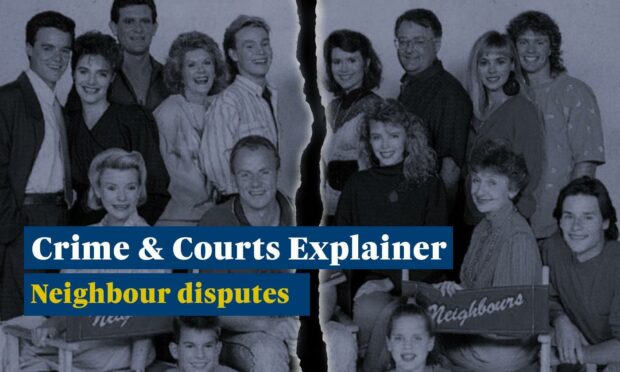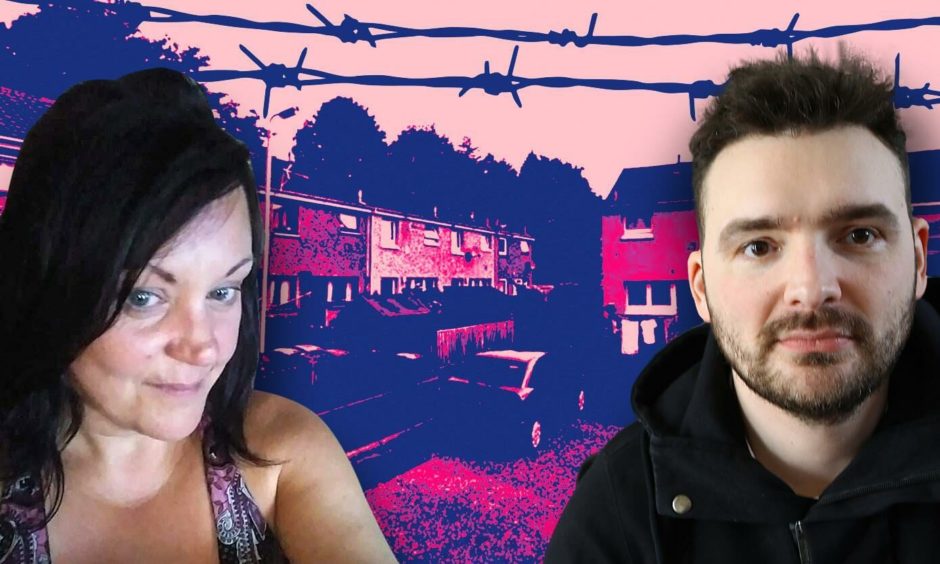Spring is springing and thoughts may be turning to gardens and home improvements.
High fences, elaborate sheds, garage conversions and house extensions , raised hot tub platforms and tree houses – all manner of elaborate schemes may be in the offing.
As Australia’s unofficial national anthem affirms — everybody needs good neighbours, especially when big property plans are afoot.
But in reality, it doesn’t always work out that way.
The latest Crime and Courts explainer examines neighbour disputes and how to avoid or get out of them.
Take, for example, the case of Perthshire engineering consultant John Watson and his wife Liz.
They live in an impressive £700,000 Art Deco home, backing onto the picturesque Blairgowrie Golf Course.
But they say they are suffering sleepless nights and disturbed daytimes thanks to sporadic shrieking from next door.
The cause of these random outbursts? Two Amazon parrots called Charlie and Bella.
Mr Watson raised an action at Perth’s Justice of the Peace Court against the parrot’s owners Iain and Sandra Gauld.
The parrots were ordered indoors after a JP court ruling in January, amid complaining of mounting legal bills.
But for others who find themselves in a neighbourly dispute, there are other ways to avoid having your grievances raise before the, ahem, beak.
Citizens Advice Scotland
Citizens Advice Scotland say such disagreements continue to be a major issue for households.
In 2019/20, the charity recorded nearly 40,000 visits to the ‘neighbour dispute’ section of its website – considerably more views than pages on coronavirus, holiday cancellations and staying in the UK after Brexit.
Volunteers deal with a wide range of conflicts, but common cases include loud music and barking dogs.
Communication is key
If you find yourself in a dispute, Citizens Advice Scotland suggests the first attempt at resolution should be talking.
- Describe the problem and the action you would like them to take.
- Think about what you are asking your neighbour to do.
- The more reasonable you are, the more likely it is that they will take action.
Alternatively, you can write to your neighbour.
- Put your case across in simple, polite terms.
- Always keep a copy of the letter you send.
- If your neighbour is a tenant, you could write to their landlord, be it private individual, the local council or a housing association.
Local help
Getting support from your resident or tenants’ association could also help.
Usually affiliated with local councils, here are the local ones:
Perth and Kinross Council Registered Tenants Organisations
Dundee Federation of Tenants Associations
Angus Tenants and Resident Groups
Fife Federation of Tenants and Residents Associations Ltd
They have a wealth of experience, information and contacts who can help.
Mediators
There are also independent mediators available that can listen to both sides of disputes.
You can find them through Scottish Mediation.
Community justice organisation Sacro also has a list of mediators on its website.
Avoid Facebook rants
At this stage, one thing you definitely shouldn’t do is post a rant about your neighbour on social media – however, tempting that might be.
When Rikki Millar opened his food business in Auchterarder, his neighbour Alison MacKenzie posted “slanderous” comments about it on Facebook.
This ignited a simmering feud between the pair which boiled over last summer when Mr Millar brought home a new puppy.
It led to Mr Millar appearing at Perth Sheriff Court on a charge of threatening or abusive behaviour.
The sheriff fined Mr Millar, but refused Ms MacKenzie’s plea for a non-harassment order.
He feared it could leave Mr Millar open to “malicious complaint” from his next door neighbour.
When communication fails
If talking doesn’t work, you can take your dispute to your local council.
Each local authority has its own strategy for neighbour disputes.
For example, if your complaint is about anti social behaviours – such as shouting, fighting, intimidation or vandalism – the council can take court action to stop it.
They also have an environmental health team to deal with complaints about, for example, loud music, smells and mess.
Environmental health officers will visit the neighbour and try and reach an immediate solution.
Failing that, they can serve a notice, ordering the neighbour to cease or take action.
You can also complain to councils about high hedges.
There is also specific advice online about dealing with boundary disputes.
Politicians
Local councillors, MPs and MSPs are also available to help. You can find your local representatives online.
Citizens Advice Scotland also provides a handy letter template you can use to contact them.
Criminal activity?
If you suspect your neighbours are up to something criminal, call the police.
It is sometimes tricky to know if the problem crosses the line into criminal behaviour, so it is best to use the force’s non-emergency number 101.
Legal action and Simple Procedure
According to Citizens Advice Scotland, legal action should be a last resort.
“Going to court might resolve the dispute but damage your relationship with your neighbours,” the website warns.
It can also be a costly venture unless you are eligible for legal aid or you can use what’s called the simple procedure.
This is a court process designed to provide a speedy, inexpensive and informal way to resolve disputes.
You do not need to use a solicitor to use the simple procedure but you can do if you wish.
Simple Procedure claims can be submitted using Civil Online, or in person at your local sheriff court.
Find a friendly compromise
Neighbourly disputes come in many guises and the ones that reach the papers are usually the most unusual or extreme examples.
But each case often involves treading a fine line between enforcing your rights – while looking after your own family and your mental health – and reaching a friendly compromise with which both sides can live.









